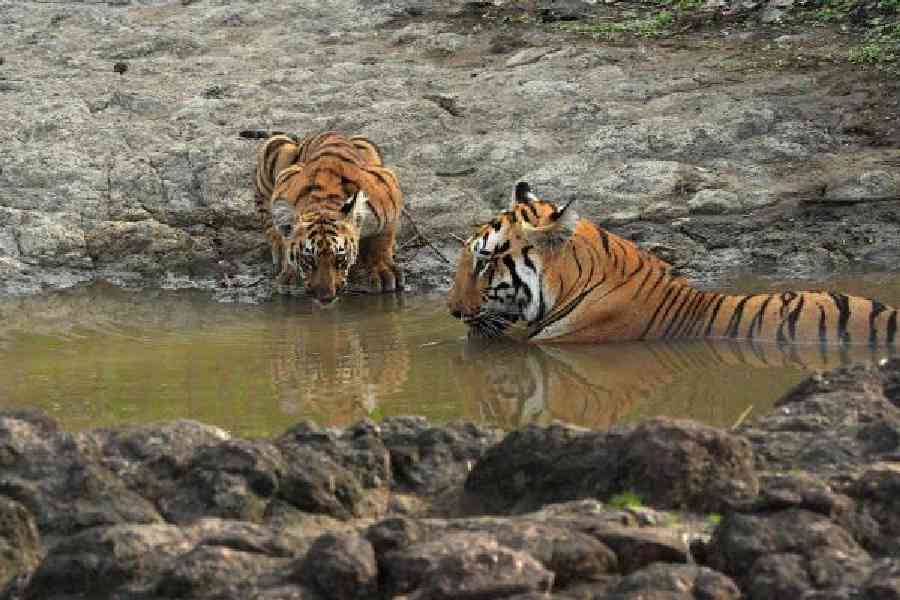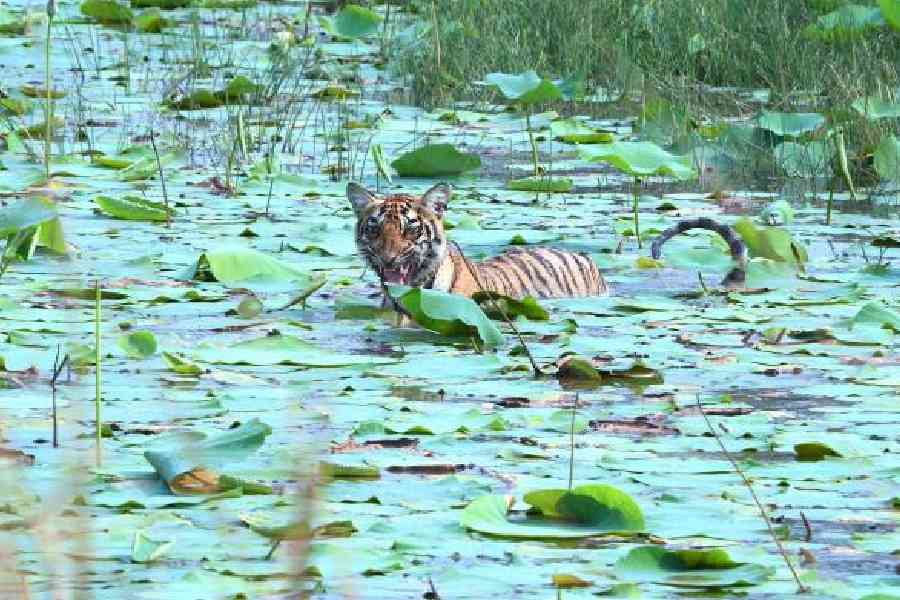The sense of freedom I draw from long road trips is incomparable. Perhaps you know the feeling — that rush when the city’s edges fall away and the road unfurls like a promise. The vast outdoors offer a strange solace: once you’ve tasted their wild diversity, there is no turning back.

Shiladitya Chaudhury
A journey into a forest is always an adventure, a quiet meeting with oneself. The noise of the world — and my own judgment — falls away. In those green silences, something within re-aligns.
Last summer, I set out in my new SUV on a 4,000km round trip across three states, exploring five tiger reserves in Maharashtra. My route began in Calcutta, skirting through Odisha and the borders of Chhattisgarh before entering the deep green heart of Maharashtra. It was a deliberate goodbye to everything totemic about city life.
The tigress called Khairi
As a child, I was spellbound by tales of forests and their creatures. Among them, one story stood out — that of Khairi, the Royal Bengal tigress raised by conservationist Saroj Raj Choudhury and his wife, Nihar Nalini Swain, in Odisha’s Simlipal forest.
Discovered as an abandoned cub by members of the Kharia tribe in 1974, Khairi was brought to Choudhury, then the field director of Simlipal Tiger Reserve. She grew up as part of the family, alongside their pet animals, never showing aggression even as she matured into a full-grown tigress. Choudhury used the opportunity to study her closely, and his pioneering work on pheromones was born from their extraordinary companionship.
Khairi’s end was tragic. In 1981, she contracted rabies after being bitten by a dog, and Choudhury, heartbroken, had her put to sleep. He died two years later, unable to bear the loss of what he called his “child”. He was 59.
That story lingered in my imagination for decades. So when I entered Simlipal, I made my way to the house where Khairi had lived — now a rest house and memorial. The forest officials who showed me around spoke fondly of her, and I felt as if the old tale had come full circle.
Between districts and days
Leaving Simlipal, we drove on to Sambalpur and rested for the night. At dawn, the SUV was back on the road, the landscape shifting every 100km — forests giving way to farmland, then to red-earthed plains. A road trip through the Indian heartland is a living atlas; the country’s texture changes faster than you can name the shades of green.
I stopped at tiny eateries along the way — where truckers laughed easily and the curries were always hot from the stove. The food at these eateries carries the pulse of the place: locally grown, freshly cooked, unpretentious.

Transit Treatment Centre at Nagpur, built for treatment of animals
In Odisha and Chhattisgarh, signs warned us to slow down. I was hopeful of sighting an elephant, a gaur, maybe a tiger or leopard. Alas! Though I saw only langurs, the air felt charged with unseen movement. Elevated animal corridors flanked the highway, designed for wildlife crossings. One such stretch revealed itself as part of the Nagzira Tiger Reserve. Peering out from my sunroof, I realised we were driving through tiger country without even knowing it.
Nagpur’s healing centre
By late afternoon, we reached Nagpur, where I was to meet my friend, Sunil Limaye, a veteran forest officer and tireless champion of wildlife conservation. He wanted me to see the Transit Treatment Centre (TTC) — a quiet facility in the Seminary Hills that rescues and rehabilitates injured animals. I feel the TTC should be a model for the nation with its comprehensive medical care facilities for wild animals in need.
Inside, a tiger that had fallen into a well, at Brahmapuri, lay under observation, its fractured limb bandaged. In another enclosure, a fawn blinked at me with liquid eyes — it had been hit by a speeding vehicle. A couple of leopards were there, one with a damaged eye. Yet the calm efficiency of the staff offered hope. Each animal that was being nursed back to good health had a backstory, and ironically enough, in most of them, the cause was a human.
The TTC is a model of compassion in practice — advanced equipment, skilled veterinarians, and an ethos of respect for every life. It deserves replication across India’s forest belts. Watching the team at work, I felt both humbled and proud of what quiet dedication can achieve.
Brahmapuri: Where forests and people collide

A mother and a cub chilling at a waterbody in Tipeswar Wildlife Sanctuary
From Nagpur, we drove to Brahmapuri, a lesser-known but tiger-rich region of Maharashtra, home to more than 100 big cats. The dense forests are interlaced with villages — a mosaic of survival and tension. Human-animal conflict here is common; farmers tending fields at dawn are the most vulnerable. These encounters happen as villagers venture into the deep forest in search of livelihood. One must remember that many little farm plots are in the forest, where the solo farmer is vulnerable to attack while tending to his crops.
Relocation is a fraught process. Tribal families, bound to ancestral lands, resist leaving; compensation and new livelihoods are complex negotiations.
While in Brahmapuri, we received grim news of a villager killed by a tiger. Limaye, still regarded as the area’s guardian, went straight to the DFO’s office. I joined him, witnessing the delicate balance between empathy and enforcement that governs conservation.
Later that evening, we ventured into the forest. The ground, still wet from rain, muffled our steps. And then — a flash of stripes. A tiger stood on the track ahead, staring straight at us.
Within seconds, I was out of the sunroof with my photography gear and clicking away at it. Tigers at Brahmapuri are unaccustomed to tourists in vehicles photographing them. This one curiously looked on… I had the presence of mind to switch off the ignition despite my obvious excitement at seeing the animal, but the SUV’s fan kept whirring loudly for a couple of minutes (technology, like nature, will have its own way at times) before shutting down. Then the animal turned and melted into the trees, silent as a shadow.
Back at the forest rest house, the ranger — soon to be transferred — and a few local village men spoke of years spent protecting this wilderness. The house itself, unfenced and deep inside the woods, was not for the faint-hearted. That night, over a simple Marathi thali, we traded stories until the forest reclaimed its quiet. Lines from The Afters’ song came to my mind: We live for moments like this, we come alive in moments like this…
Umred–Karhandla: Waiting for F2
At dawn, a new reserve awaited — Umred–Karhandla, famed for a tigress known as F2. She had recently birthed five cubs, and sighting the family was the dream of every wildlife photographer.
Hours of waiting followed. There was nothing to do but wait and wait, which I did. The minutes rolled into hours as I hung on patiently, hoping to get a good shot as I could only make her out off and on somewhere in the distance, vaguely. Around 2pm, we returned to have our lunch, having been out since 5.30am.
Then, word came: F2 had made a kill. By the time I reached the spot, she and her cubs were feasting, their faces stained with the crimson of a spotted deer. When they had eaten their fill, the cubs began to play, tumbling over the remains in mock hunts. My only regret is that I could not manage the precise shots that I had in mind. While pro models will, wild animals won’t pose the way one wishes. It was a silent reminder to myself.
It was a scene of raw beauty — a reminder that the wilderness runs by its own clock, indifferent to our anticipation. Before leaving, I looked up to see another tiger resting high on a branch, watching me with regal detachment. Such moments are gifts, unplanned and unforgettable.
Tadoba–Andhari: The beating heart of the wild
Tadoba–Andhari is Limaye’s domain — he has spent years shaping its conservation efforts. For me, it feels like second home. I have visited more than 40 times in 18 years, and each return deepens my respect for its rhythms.
This time, we stayed at a rest house beside the iconic Tadoba Lake, within the territory of the famed tigress Maya. Alone one afternoon, I wandered the forest, camera in hand. In a day-and-a-half, I sighted 11 tigers — adults, sub-adults, cubs — an astonishing concentration of life.
While resting under a tree near Pandharponi Lake, I witnessed a hawk-eagle swoop down, snatch a squirrel, and tear into it on a branch above. The violence shocked me, yet it was a vivid lesson in nature’s design — the food chain in motion, beautiful and brutal at once.
Evenings were for conversation. Limaye, ever the raconteur, recounted decades of fieldwork — rescues, raids, and the quiet diplomacy needed to keep both animals and people safe.
Tipeshwar: Shadows of T1
Our next stop, Tipeshwar Wildlife Sanctuary, straddling Maharashtra and Telangana, is lush and remote — the site of the infamous T1 or Avni case that gripped the nation in 2018. Declared a man-eater after killing 13 people, T1 was hunted down despite efforts to capture her alive. Limaye, then overseeing operations, still speaks of her with sorrow.
We visited the forest temple where Limaye once prayed for a peaceful resolution. Sitting beside him, I sensed the weight of those days — the fatigue, the public scrutiny, the moral burden of pulling a trigger in the name of safety.
The highlight of my sojourn in Tipeshwar was being in the august presence of Sunil Limaye and exploring his karmbhoomi. He showed me the rest house where he had camped through the tense weeks of the search. For me, the visit was a pilgrimage of sorts — not to tragedy, but to the complexity of coexistence.
We lunched at Tipai, an eco-retreat that fuses sustainability with comfort, run largely by locals and serving organic food sourced from within a few kilometres. As we left, a vision rewarded me: a tigress reclining in a stream, her three cubs splashing around her. No other vehicle, no noise — just a family at peace. Through my lens, she looked up once, calm and unconcerned. A perfect farewell image.
Next stop: Navegaon–Nagzira
With Limaye flying home from Nagpur, I turned the wheel toward Navegaon–Nagzira, the final reserve on my itinerary. I made a brief reconnaissance, more to feel the lay of the land than to chase another sighting. The forests were quieter, the air heavy with the scent of sal and teak. I promised myself I would return.
Homeward bound
When the forests finally receded and the highways stretched east toward Calcutta, a familiar melancholy set in. The road, like the wild, has a way of changing you quietly.
Perhaps, a decade down the line, I might shift to one in Maharashtra and operate from there, who knows. It’s certainly a dream worth dreaming. As dusk deepened, I caught myself humming Willie Nelson’s On the Road Again: Going places that I’ve never been, Seein’ things that I may never see again….
Shiladitya Chaudhury is a communication consultant and a restaurateur with brands like Oudh 1590, Chapter 2 and Chaudhury & Company. His passion for wildlife photography takes him to the remotest of jungles.
Cameras used: Sony A7 Mark 3 with 200-600 lens and Sony RX10 Mark 4











